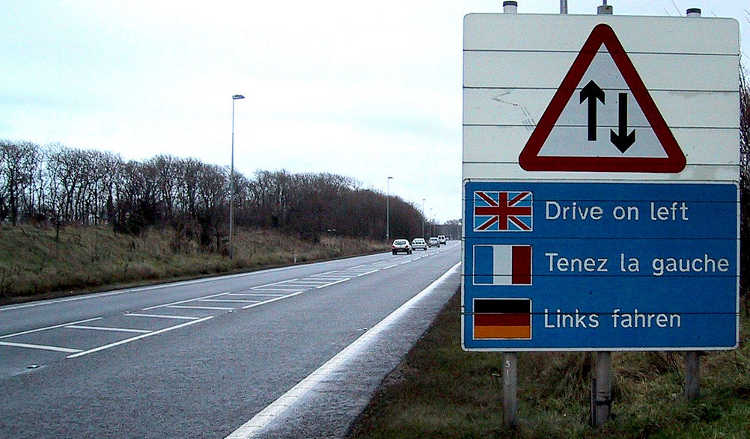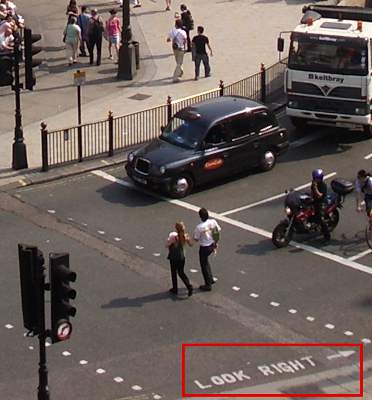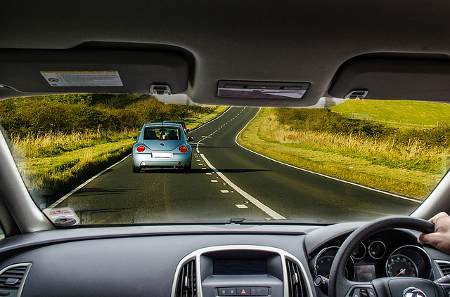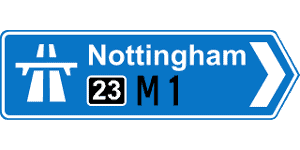Driving on the left
The biggest shock for foreigners driving in England or Britain is driving on the left side of the road. Everything is reversed when compared to driving on the right side of the road. When you want to overtake, you overtake by the right, when you go around a roundabout, you go around in a clockwise direction. You must take extra care when you want to turn right because you will be crossing another lane of traffic.
It is easy to remember to drive on the left side of the road when there is lots of other traffic because you can simply follow the other cars in front of you but it is a lot harder to remember when you are on an empty road and perhaps feeling a little tired.
Close to the ports in the south east of England where cars and drivers are arriving from Europe via the ferries, there are signs to remind people to drive on the left:

Also, in London, there are signs on the roads for pedestrians to remind them to look to the right for cars:

Why do we drive on the left in Great Britain?
In fact everybody from all over the world used to travel on the left side of the road until the end of the 18th century. The reason makes perfect sense. During that time, people travelled on horseback and when they passed a stranger coming the opposite direction, they wanted the other person to pass them on the side of their right arm so that they could defend themselves properly with their sword!
Other countries changed after the French revolution because Napoleon was left-handed and he wanted to approach his enemies from the opposite side. From that time, countries who were colonised by the French drove on the right and countries who were colonised by the British chose to drive on the left. Since the USA was partly colonised by the French, Spanish and Portugese (who all drove on the right) and only partly colonised by the British, the USA decided to drive on the right. Once the USA had decided to drive on the right, most other countries followed.
Today, approximately 25% of the world continues to drive on the left, mostly old British colonies.
Steering wheel on the right

Of course, since we drive on the left side of the road, that means that the steering wheel is on the right! This makes driving very different. You will now be changing the gears and using the handbrake with your left hand. However each of the individual gears are in the same position (First gear: top left, second gear: bottom left etc.)
The pedals are also in the same order as a left hand drive car: The first pedal is the clutch, the second is the brake and the third is the accelerator. Most cars in Britain are manual cars. If you want to hire an automatic, you must make that very clear when you are booking. If you do not specify, they will give you a manual car to drive.
The speeds on the speedometer of the car are in miles per hour. Some cars might also have the equivalent speeds in kilometres per hour, but not necessarily. Be careful, because a given speed in miles per hour is a lower number than for the same speed in kilometres an hour. For example, 70 mph is equivalent to 112 kph
The roads
There are 3 categories of main roads. In order of size:
- B roads – Example the B108 in London.
- A roads – Example the A57 which runs from Liverpool to Lincoln
- M roads (Motorways) – Example the M1 which runs from London to Leeds.

Most of the roads and motorways are free. There are very few motorways where you must pay a toll.
Distances and speed limits
The unit of distance on all road signs is the mile. So if you see a sign which reads “London 12”, that means that London is 12 miles away. For information, 1 mile = 1.6 kilometres.
The speed limits are also indicated by road signs in miles per hour. The speed limits for a car are as follows unless otherwise indicated by a road sign (I have put the equivalent speed in kph for information only):
- In a town or city: 30 mph (48 kph)
- Single carriageway outside of any towns: 60 mph (97 kph)
- Dual carriageway: 70 mph (113 kph)


Student English says
Hai! also the same thing in here, we drive on the left side but I never know why we are and the history that. could you also make writing about weather in the UK. thanks for your lessons that very useful …. Cheers!
RickyD286 says
It’s really interesting information. Now I learnt more things about your country.
In VietNam, we drive on the left so it’s a little different than yours but it’s not a big deal, right?
By the way, I love your articles 🙂
Boyer G says
Very interesting.! I was wondering why The American drive on the right, I got the answer now.
Carol says
One thing I found difficult about driving in England was where to follow the car ahead. As an American, I’m used to being in the left side of a car and thus following the left side of the car ahead. I was generally fine with the turns, but I found myself drifting to the left (not the right, which is what you might think would happen) because I kept feeling like I should be behind the left side of the car ahead. We ended up nearly off the road at times, but at least not in the path of oncoming cars.
Mudrc says
Why would you defend your self with sword (riding left side), when you can defend yourself with shield (riding right side). Makes no sense.
Shyani shashikala says
Useful explanation thank you.!